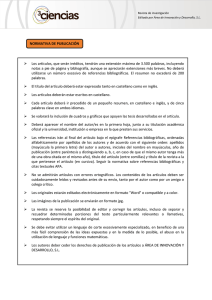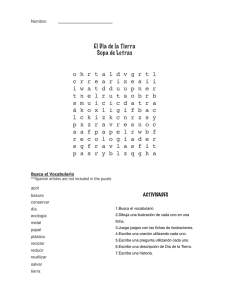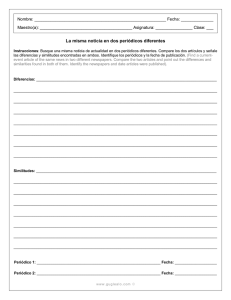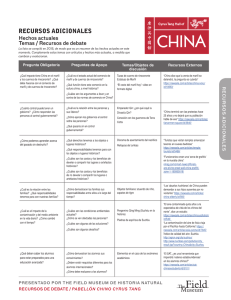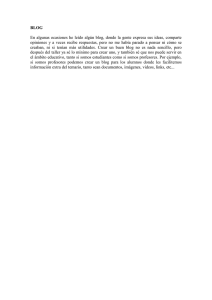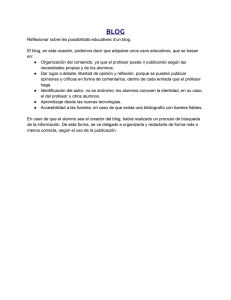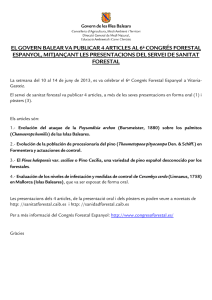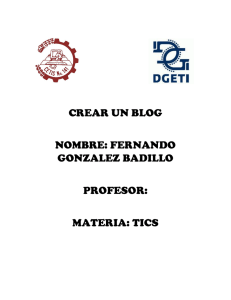end
Anuncio
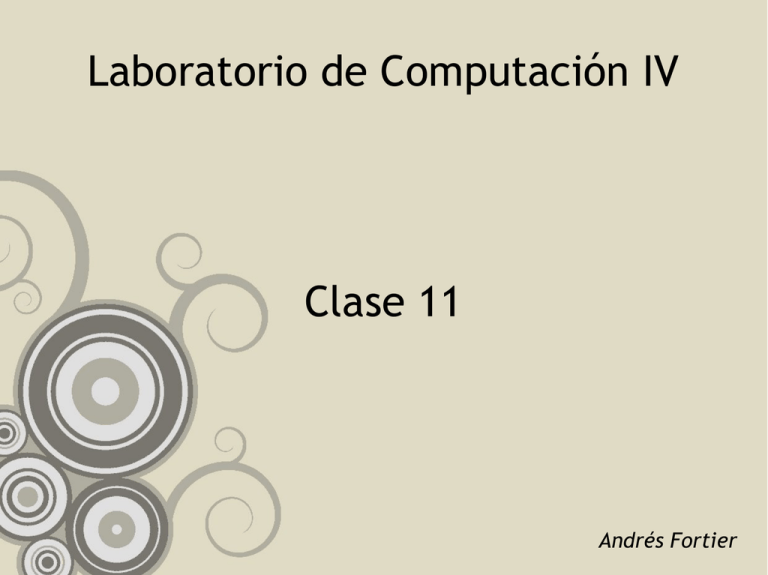
Laboratorio de Computación IV
Clase 11
Andrés Fortier
Repaso
●
Llegamos a tener el índice de artículos en
http://localhost:3000/
/app/views/articles/index.html.erb
<h1> Indice </h1>
●
Ahora necesitamos tener un modelo
persistente
RoR – Modelos y Persistencia
●
Rails utiliza
–
Una BD relacional para persistir datos.
–
Un mecanismo para “mapear” objetos a la BD.
●
●
Un poco sobre ORMs.
ActiveRecord: Implementación del patrón con
el mismo nombre.
An object that wraps a row in a database table or
view, encapsulates the database access, and adds
domain logic on that data.
ActiveRecord
Cuenta
titular
saldo
all()
where(filter)
...
save()
delete()
…
depositar(unMonto)
...
titular
saldo
“Juan Perez”
$1.500,00
“Jose Julio”
$300.000,00
“Anastacio Ponce”
$12,50
c = Cuenta.new(“Pepe”)
c.save
c.depositar(100)
c.save
Cuenta.all
Cuenta.where({titular: “Pepe”})
RoR - Migrations
●
●
BD
–
Esquema.
–
Datos.
Problema para manejar una BD:
–
En desarrollo alguien agrega una tabla.
–
Replicar ese cambio en otros ambientes de
desarrollo.
–
Replicar ese cambio en producción.
–
Sin perder datos!
RoR - Migrations
●
●
●
Migration: un cambio incremental a la BD.
Generalmente esquema, pero a veces también
datos.
Ejemplo
class CreateProducts < ActiveRecord::Migration
def change
create_table :products do |t|
t.string :name
t.text :description
end
end
end
RoR - Migrations
●
Ventajas
–
No hay que escribir SQL
●
Pero no vivimos en un mundo ideal, a veces hay que
hacerlo
–
RoR no aplica dos veces la misma migration.
–
Versionamiento de la BD en código.
–
Muchas veces son reversibles automáticamente.
Blog – Modelo
●
Crear un modelo con ActiveRecord usando un
generador
$ bin/rails generate model Article title:string text:text
invoke active_record
create db/migrate/20150418202101_create_articles.rb
create app/models/article.rb
$ cat app/models/article.rb class Article < ActiveRecord::Base
end
Blog – Modelo
$ cat db/migrate/20150418202101_create_articles.rb class CreateArticles < ActiveRecord::Migration
def change
create_table :articles do |t|
t.string :title
t.text :text
t.timestamps
end
end
end
$ bin/rake db:migrate
== 20150418202101 CreateArticles: migrating =================
­­ create_table(:articles)
­> 0.0041s
== 20150418202101 CreateArticles: migrated (0.0042s) ========
Blog – Modelo
$ bin/rake db:migrate
$
Blog – Modelo
$ cat db/schema.rb # encoding: UTF­8
# This file is auto­generated from the current state of the database. Instead
# of editing this file, please use the migrations feature of Active Record to
# incrementally modify your database, and then regenerate this schema definition.
...
Blog – Modelo
...
# Note that this schema.rb definition is the authoritative source for your
# database schema. If you need to create the application database on another
# system, you should be using db:schema:load, not running all the migrations
# from scratch. The latter is a flawed and unsustainable approach (the more migrations
# you'll amass, the slower it'll run and the greater likelihood for issues).
#
# It's strongly recommended that you check this file into your version control system.
...
Blog – Modelo
...
ActiveRecord::Schema.define(version: 20150418202101) do
create_table "articles", force: true do |t|
t.string "title"
t.text "text"
t.datetime "created_at"
t.datetime "updated_at"
end
end
Blog – Modelo
$ bin/rails dbconsole
SQLite version 3.8.2 2013­12­06 14:53:30
Enter ".help" for instructions
Enter SQL statements terminated with a ";"
sqlite> .tables
articles schema_migrations
sqlite> .schema articles
CREATE TABLE "articles" (
"id" INTEGER PRIMARY KEY AUTOINCREMENT NOT NULL,
"title" varchar(255),
"text" text,
"created_at" datetime,
"updated_at" datetime);
sqlite> select * from articles;
Blog – Modelo
sqlite> .schema schema_migrations
CREATE TABLE "schema_migrations" ("version" varchar(255) NOT NULL);
CREATE UNIQUE INDEX "unique_schema_migrations" ON "schema_migrations" ("version");
sqlite> select * from schema_migrations;
20150418202101
Blog – Modelo
●
En otra consola
$ bin/rails console
Loading development environment (Rails 4.1.8)
2.0.0­p598 :001 > post = Article.new(title: 'First post!', text: 'Hi there')
=> #<Article id: nil, title: "First post!", text: "Hi there", created_at: nil, updated_at: nil> 2.0.0­p598 :002 > post.save!
(0.3ms) begin transaction
SQL (1.4ms) INSERT INTO "articles" ("created_at", "text", "title", "updated_at") VALUES (?, ?, ?, ?) [["created_at", "2015­04­18 20:42:38.820519"],
["text", "Hi there"], ["title", "First post!"], ["updated_at", "2015­04­18 20:42:38.820519"]]
(203.6ms) commit transaction
=> true Blog – Modelo
●
En la consola de la BD
sqlite> select * from articles;
1|First post!|Hi there|2015­04­18 20:42:38.820519|2015­04­18 20:42:38.820519
Blog – Modelo
●
En la consola de rails
2.0.0­p598 :004 > Article.new(title: 'Second post', text: 'Post body').save!
(0.1ms) begin transaction
SQL (1.1ms) INSERT INTO "articles" ("created_at", "text", "title", "updated_at") VALUES (?, ?, ?, ?) [["created_at", "2015­04­18 20:45:46.491115"], ["text", "Post body"], ["title", "Second post"], ["updated_at", "2015­04­18 20:45:46.491115"]]
(173.6ms) commit transaction
=> true Blog – Modelo
●
En la consola de rails
2.0.0­p598 :005 > Article.all
Article Load (0.4ms) SELECT "articles".* FROM "articles"
=> #<ActiveRecord::Relation [#<Article id: 1, title: "First post!", text: "Hi there", created_at: "2015­04­18 20:42:38", updated_at: "2015­04­18 20:42:38">, #<Article id: 2, title: "Second post", text: "Post body", created_at: "2015­04­18 20:45:46", updated_at: "2015­04­18 20:45:46">]> Blog – Artículos
●
Ya tenemos lo necesario para mostrar algo en
el índice
/app/controllers/articles_controller.rb
class ArticlesController < ApplicationController
def index
@articles = Article.all
end
end
Blog – Artículos
/app/views/articles/index.html.erb
<h1>Articles</h1>
<% @articles.each do |article| %>
<h3><%= article.title %></h3>
<p> <%= article.text %> </p>
<% end %>
Blog – Artículos
Blog – Artículos
●
Veamos ahora como linkear y ver un artículo.
–
Necesitamos una nueva ruta con un identificador.
config/routes.rb
Rails.application.routes.draw do
root 'articles#index'
get '/articles' => 'articles#index'
get '/articles/:id' => 'articles#show'
get 'hello' => 'example#hello'
end
Blog – Artículos
●
En el controller
/app/controllers/articles_controller.rb
class ArticlesController < ApplicationController
...
def show
@id = params[:id]
end
end
Blog – Artículos
●
En la vista
/app/views/articles/show.html.erb
<h1><%= @id %></h1>
Blog – Artículos
●
En la vista
/app/views/articles/show.html.erb
<h1><%= @id %></h1>
Blog – Artículos
●
Volvamos al controller
/app/controllers/articles_controller.rb
class ArticlesController < ApplicationController
...
def show
@article = Article.find(params[:id])
end
end
Blog – Artículos
●
Volvamos a la vista
/app/views/articles/show.html.erb
<h1>
<%= @article.title %>
</h1>
<p>
<strong>Text:</strong>
<%= @article.text %>
</p>
Blog – Artículos
Blog – Artículos
Blog – Artículos
●
Linkeemos desde el index
/app/views/articles/index.html.erb
<h1>Articles</h1>
<% @articles.each do |article| %>
<h3>
<a href="articles/<%= article.id %>">
<%= article.title %>
</a>
</h3>
<% end %>
Blog – Artículos
●
Rails provee helpers para las vistas
–
Pero previamente tenemos que darle un nombre a
la ruta. Modifiquemos la definición de rutas:
config/routes.rb
Rails.application.routes.draw do
root 'articles#index'
get '/articles',
to: 'articles#index',
as: 'articles'
get '/articles/:id',
to: 'articles#show',
as: 'article'
end
Blog – Artículos
●
Veamos las rutas
$ bin/rake routes
Prefix Verb URI Pattern Controller#Action
root GET / articles#index
articles GET /articles(.:format) articles#index
article GET /articles/:id(.:format) articles#show
Blog – Artículos
●
Ahora podemos modificar nuestra vista
/app/views/articles/index.html.erb
<h1>Articles</h1>
<% @articles.each do |article| %>
<h3>
<%= link_to article.title, article_path(article) %>
</h3>
<% end %>
Blog – Artículos
●
Y en la vista individual
/app/views/articles/show.html.erb
<h1>
<%= @article.title %>
</h1>
<p>
<strong>Text:</strong>
<%= @article.text %>
</p>
<%= link_to 'Back to index', articles_path %>
Links
●
●
●
●
●
http://guides.rubyonrails.org/v4.2.6/getting_
started.html
http://edgeguides.rubyonrails.org/active_rec
ord_migrations.html
http://www.martinfowler.com/eaaCatalog/act
iveRecord.html
http://guides.rubyonrails.org/active_record_b
asics.html
http://guides.rubyonrails.org/command_line.
html
